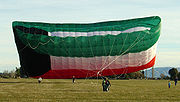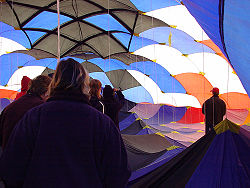
Peter Lynn
Encyclopedia

Peter Lynn is a New Zealand
New Zealand
New Zealand is an island country in the south-western Pacific Ocean comprising two main landmasses and numerous smaller islands. The country is situated some east of Australia across the Tasman Sea, and roughly south of the Pacific island nations of New Caledonia, Fiji, and Tonga...
kitemaker, engineer
Engineer
An engineer is a professional practitioner of engineering, concerned with applying scientific knowledge, mathematics and ingenuity to develop solutions for technical problems. Engineers design materials, structures, machines and systems while considering the limitations imposed by practicality,...
and inventor. He is notable for his construction of the world's largest kites (Guinness book of records holders), giant inflatable (sparless) display kites (the most widely-known is the 27 m octopus kite), the popularisation of kite buggying and contributions to the development of power kiting and kitesurfing
Kitesurfing
Kitesurfing or Kiteboarding is an adventure surface water sport that has been described as combining wakeboarding, windsurfing, surfing, paragliding, and gymnastics into one extreme sport. Kitesurfing harnesses the power of the wind to propel a rider across the water on a small surfboard or a...
. He spends much of the year travelling worldwide and displaying his kites at International Kite Festivals.
Lynn, together with his wife Elwyn, established a kite business at Ashburton, New Zealand
Ashburton, New Zealand
Ashburton is a town and district in the Canterbury Region on the east coast of the South Island of New Zealand. It is the third-largest centre in Canterbury, after Christchurch and Timaru. The area around Ashburton is frequently referred to as Mid Canterbury, which is also the name of the...
, in 1973, producing single-line kites for children. In 1974 he developed the Peter Lynn Triangular box kite, a framed triangular form cellular single line kite. Beginning in 1984 with the Centipede design, he then developed large creature-themed display kites for the growing number of international kite festivals. These large-scale sparless kites include the manta ray, octopus, puffer-fish, gecko and trilobite.http://www.peterlynnkites.co.nz/kites/bigkites/bigkites.htm
In 1987 he began developing power kite
Power kite
A power kite or traction kite is a large kite designed to provide significant pull to the user.They come in three main forms: foils, leading edge inflatables and supported leading edge. There are also rigid-framed kites and soft single skin kites. There are several different control systems used...
s for traction uses, and designing boats, buggies, boards and snow sleds to use with them. The sport of kite buggying in its modern form began from a kitesailing craft he developed. It was equipped with three 'skis' and was quite unsuccessful on the water. In 1990 he converted it to a land buggy by replacing the skis with wheels. More than 10,000 of his buggies are now in use, and there are also many other kite buggy manufacturers. Kite buggying has become a popular world wide sport.

Airfoil
An airfoil or aerofoil is the shape of a wing or blade or sail as seen in cross-section....
by the use of variable length cords rather than the fixed rib used in a conventional wing or ram-air parafoil
Parafoil
A parafoil is a nonrigid airfoil with an aerodynamic cell structure which is inflated by the wind. Ram-air inflation forces the parafoil into a classic wing cross-section. Parafoils are most commonly constructed out of ripstop nylon....
such as a parachute
Parachute
A parachute is a device used to slow the motion of an object through an atmosphere by creating drag, or in the case of ram-air parachutes, aerodynamic lift. Parachutes are usually made out of light, strong cloth, originally silk, now most commonly nylon...
.
In 1995 he designed the ram-air inflated Megabite, a 635 square metre kite. It was accepted as the world’s largest kite by Guinness in 1997. When on the ground, more than 1000 people can comfortably stroll around inside it. He also designed the current Guinness record holder, a 1019 square metre Kuwait flag
Flag of Kuwait
The flag of Kuwait was adopted on September 7, 1961, and officially hoisted November 24, 1961.Before 1961, the flag of Kuwait, like those of other Gulf states, was red and white with the word "الكويت" in the middle. The present flag is in the Pan-Arab colours, but each colour is also significant...
, which took over the world record from the Megabite in 2005. That same year, he built two additional identically-sized kites (Mega Flag in the United States and Mega Moon in Japan), allowing for more exhibitions of the World's Largest Kites around the world.
In 1997 he developed the first ‘hybrid’ traction kite. It is referred to as hybrid as the form is a single skin kite supported by a combination of both aerodynamic forces and a flexible frame. Conventional traction kites use either a rigid frame inflated with a pump prior to launching or ram air inflated cavities.
In 1999 he developed the first bridleless arch style ram air kite, primarily for kitesurfing. Arc style kites
Arc kite
The arc kite or twinskin kite is a type of traction kite designed and patented by Peter Lynn. It is a very stable, safe and secure type of powerkite. It can be used for all kinds of kite powered sports, for example: Kiteboarding, Landboarding or Snowkiting. The shape of the kite is similar to a C...
are generally more efficient (better upwind performance) and are more resistant to luffing
Luffing
In sailing, luffing refers to when a sailing vessel is steered far enough toward the direction of the wind , or the sheet controlling a sail is eased so far past optimal trim, that airflow over the surfaces of the sail is disrupted and the sail begins to "flap" or "luff"...
(more stable and reliable in gusty conditions) relative to leading edge inflatable
Leading edge inflatable kite
A leading edge inflatable kite or LEI is a single skin kite with inflatable bladders providing structure. It is useful as a power or traction kite. These kites are flown using 2, 4 or 5 control lines and a bar. A LEI is a great kite for water use because the inflated bladders cause it to float on...
(LEI) sled kites but have slightly lower lift coefficient
Lift coefficient
The lift coefficient is a dimensionless coefficient that relates the lift generated by a lifting body, the dynamic pressure of the fluid flow around the body, and a reference area associated with the body...
(less power from the same size kite).
More recently he has developed the KiteSled (see image), for kite powered snow expeditioning. It steers by bending its skis, which are constructed from multiple longitudinal elements dovetailed together. Using KiteSleds, in May 2006 Australians Patrick Spiers and Ben Deacon completed a 700 km trans-Greenland
Greenland
Greenland is an autonomous country within the Kingdom of Denmark, located between the Arctic and Atlantic Oceans, east of the Canadian Arctic Archipelago. Though physiographically a part of the continent of North America, Greenland has been politically and culturally associated with Europe for...
journey that they believe was 20% faster than would have been possible by kite skiing
Kite skiing
Kite skiing is a relatively recent development of skiing where the pull comes from a kite. It can be done on water, snow, land or ice.Kite skiing on snow has little in common with downhill skiing which is very popular in the alps and on mountains around the world...
.

In other fields, his inventions include:
1975. The original ‘tipping blade’ portable sawmill
Portable sawmill
Portable sawmills became popular in the United States starting in the 1970s, when the 1973 energy crisis and the back to the land movement had led to renewed interest in small woodlots and in self-sufficiency.- History :...
system, using a single (circular) saw blade which rotates 90 degrees at the end of each pass through a log to enable the production of sawn timber in one operation. While he held the patent on this invention until 1980, after the patent lapsed it became the world standard portable sawmill system.
1987. Started Stirling Research Ltd, and with Dr. Donald Clucas began the development of a stirling cycle engine
Stirling engine
A Stirling engine is a heat engine operating by cyclic compression and expansion of air or other gas, the working fluid, at different temperature levels such that there is a net conversion of heat energy to mechanical work....
generator for yachts (and later for in-home combined heat and power systems
MicroCHP
Micro combined heat and power or micro-CHP is an extension of the now well established idea of cogeneration to the single/multi family home or small office building.- Overview :...
). From 1991, Dr Clucas continued this development through to commercialisation with WhisperGen, a business formed for this purpose by elements of the NZ electricity industry.
Lynn’s father, Robert Frederick (1914–) is the founder of the Lynn Historic Woodworking Trust Inc. a collection of historic woodworking tools, equipment and archives, including the world’s largest collection of ornamental turning lathes. It is sited at The Plains, a colonial era museum park in Ashburton, NZ. Robert Fredrick Lynn was awarded the Queen's Service Order in the New Years Honours list 2007.http://www.dpmc.govt.nz/honours/lists/list.asp?id=38
Patents
Traction kite design, filed April 2002, issued March 2006 Ram air inflated wing, filed November 2002, issued January 2005External links
- Peter Lynn's Website {Learn more about him and his work}
- Peter Lynn kites (URL accessed 23-May-2006)
- Peter Lynn Kiteboarding (URL accessed 30-July-2009)

